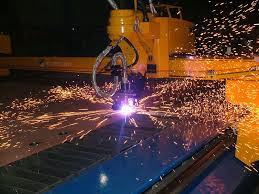Category: computers
The Advantages of CNC Plasma Cutting
 Plasma cutting is a technique that’s been used for cutting metal precisely and accurately since the 1960s. However, it’s become even more precise and accurate over the past thirty years with the advent of CNC—or computer-controlled—plasma cutting tables. While other types of precision cutting, such as laser and waterjet, have been developed as well, CNC plasma cutting remains a top choice for efficient, economical precision cutting.
Plasma cutting is a technique that’s been used for cutting metal precisely and accurately since the 1960s. However, it’s become even more precise and accurate over the past thirty years with the advent of CNC—or computer-controlled—plasma cutting tables. While other types of precision cutting, such as laser and waterjet, have been developed as well, CNC plasma cutting remains a top choice for efficient, economical precision cutting.
In plasma cutting, an electrical charge ionizes compressed gas being blown through a tight, focused nozzle. As a result, the gas changes to the fourth form of matter, known as plasma. The plasma carries the electrical charge to the metal being cut, creating a circuit and melting the metal. Essentially, it’s like using controlled lightning to make your cut. Plasma cutters are capable of being so precise that Scientific American reports the medical industry is experimenting with plasma scalpels to be used in surgery, in order to cut and cauterize simultaneously!
In an industrial setting, CNC (Computer Numeric Control) plasma cutting gives the most control over accuracy and precision. The computer is pre-programmed with the design to be cut, following a CAD drawing. There are pre-made libraries of shapes available, too. This automation allows for near-exact replication when cutting multiple pieces. In addition, today’s CNC plasma cutting tables can perform either standard 2-axis cutting, for 90 degree edges, or cutting along three or more axes in order to create beveled edges.
As for the metal being cut, plasma cutters can work with many different types, including both ferrous and non-ferrous metals. Some plasma cutters can cut through metal up to three inches thick. Plus, they’re efficient—able to cut at speeds up to 500 inches per minute. Varying table sizes and lengths allow CNC plasma cutters to handle metal of different dimensions. Plasma cutters can even cut material that’s underwater.
And CNC plasma cutters can do all this while being much less expensive than similar-sized laser cutters. In fact, plasma cutting can cost as little as one-third as much as laser cutting. It’s also generally quicker and easier to learn to operate a plasma cutter, and plasma cutters don’t require the complicated adjustments that laser cutters do.
Because plasma cutters are so economical, adaptable, cost-effective, and relatively easy to use, they’re used for a wide variety of applications. Small, hand-held plasma cutters can be found in hobbyists’ workshops, while the largest CNC plasma cutting tables can be found in places like shipyards, where they’re used to cut the steel for military vessels. Here in Huntsville, al.com reports that the Drop Metal design and fabrication studio uses CNC plasma cutting to produce some of their amazing creations, such as signs with various fonts and logos, as well as furniture, sculptures, and lighting fixtures.
CNC plasma cutting is also popular in the HVAC industry, where it’s used for precisely cutting metal into various shapes for ductwork. And it’s used in the automotive industry, not just in factories that manufacture vehicles but also in custom body shops. In short, in any industry where precise and accurate production of metal components is needed, they’re likely to use CNC plasma cutting.
Benefits of CDR Media
 The term “CD-R” refers to a CD that allows you to record files. Originally CDs were only recordable by companies with major resources, whereas now anyone with a CD-R drive can do it.Writing files to a CD has a large number of benefits for businesses of all sizes. These benefits include-Easy Transfer It’s easy to transfer files from one computer to another using a CD-R. It’s especially useful to use CDs in this manner when the files that you need to transfer are too large for email attachments. The portability of a CD-R also means that it won’t be cumbersome to move the CD from one location to another the way it might be with a portable hard drive, for example.
The term “CD-R” refers to a CD that allows you to record files. Originally CDs were only recordable by companies with major resources, whereas now anyone with a CD-R drive can do it.Writing files to a CD has a large number of benefits for businesses of all sizes. These benefits include-Easy Transfer It’s easy to transfer files from one computer to another using a CD-R. It’s especially useful to use CDs in this manner when the files that you need to transfer are too large for email attachments. The portability of a CD-R also means that it won’t be cumbersome to move the CD from one location to another the way it might be with a portable hard drive, for example.
-Backups
It’s also very useful to use CD-Rs in a backup capacity. In the course of running a business, it’s often essential to make sure that certain files, often in the form of records, are backed up properly. In the past, this often took the form of actual physical paper files. But now, it makes a lot more sense to have electronic versions, especially since the amount of data that one CD can hold can be equal to an entire filing cabinet full of paper. Read More
